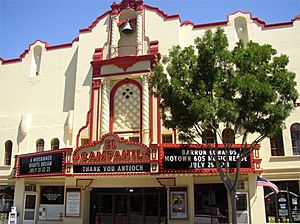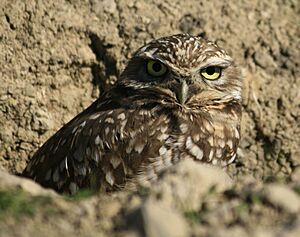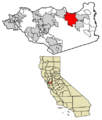Antioch, California facts for kids
Quick facts for kids
Antioch, California
|
|||||
|---|---|---|---|---|---|
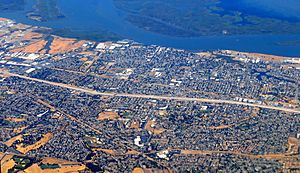
View of Antioch
|
|||||
|
|||||
| Motto(s):
Opportunity Lives Here
|
|||||
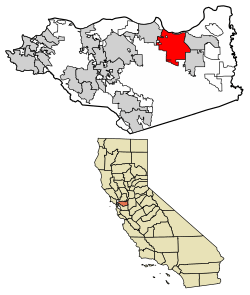
Location of Antioch in Contra Costa County, California
|
|||||
| Country | United States | ||||
| State | California | ||||
| County | Contra Costa | ||||
| Incorporated | February 6, 1872 | ||||
| Area | |||||
| • City | 29.94 sq mi (77.55 km2) | ||||
| • Land | 29.17 sq mi (75.55 km2) | ||||
| • Water | 0.77 sq mi (2.00 km2) 2.52% | ||||
| Elevation | 43 ft (13 m) | ||||
| Population
(2020)
|
|||||
| • City | 115,291 | ||||
| • Rank | 3rd in Contra Costa County 55th in California |
||||
| • Density | 3,952.25/sq mi (1,525.96/km2) | ||||
| • Urban | 326,205 (US: 124th) | ||||
| • Urban density | 4,447.4/sq mi (1,717.2/km2) | ||||
| • Metro | 7,468,390 | ||||
| Time zone | UTC−8 (Pacific) | ||||
| • Summer (DST) | UTC−7 (PDT) | ||||
| ZIP codes |
94509, 94531
|
||||
| Area code | 925 | ||||
| FIPS code | 06-02252 | ||||
| GNIS feature IDs | 1657936, 2409715 | ||||
Antioch is a city in California, located in the East Bay region of the San Francisco Bay Area. It sits along the Sacramento–San Joaquin River Delta. In 2020, about 115,291 people lived there, making it the third-largest city in Contra Costa County, California. The city has become much more diverse since the 1970s.
Contents
- Antioch's History: A Look Back
- Antioch's Location and Weather
- Antioch's Population: Who Lives Here?
- Antioch's Economy: Jobs and Businesses
- Arts and Culture in Antioch
- Open Spaces and Wildlife
- Education in Antioch
- Media: News in Antioch
- Transportation in Antioch
- Notable People from Antioch
- Sister cities
- Images for kids
- See also
Antioch's History: A Look Back
Early Days: From Marsh's Landing to Antioch (1850s-1900s)
Antioch is one of California's oldest towns. In 1848, John Marsh built a landing on the San Joaquin River. This spot, called Marsh's Landing, was a busy shipping point for his huge ranch. Ships could dock there all year round.
In 1850, two brothers, William and Joseph Smith, started a town nearby. They named it Smith's Landing. A year later, a minister convinced people to rename it Antioch, after a city in the Bible.
Around 1859, coal was found in the hills south of Antioch. Coal mining became a major business, leading to new towns like Nortonville and Black Diamond. This boosted Antioch's economy. Later, copper was discovered in 1863, and a smelting plant was built. However, the copper boom didn't last. Oil was also drilled for in 1865, but not enough was found to be profitable.
The Antioch Post Office opened in 1851. It closed and reopened a few times before staying open continuously since 1863. Antioch officially became a city in 1872.
The Antioch Ledger newspaper started on March 10, 1870. Its first issue was small and only reported on a women's suffrage meeting. The Ledger later joined with the Contra Costa Times and stopped printing in 2005.
Modern Antioch: Growth and Change
In the mid-1950s, a company in Antioch invented a way to put wax coatings on cardboard. This led to the first milk, juice, and ice cream cartons, making Antioch known as "the home of the milk carton."
Today, Antioch is mostly a "bedroom community." This means many adults live there but work in bigger cities like Oakland and San Francisco. The city has grown a lot in the last 30 years. More people move to Antioch as housing prices in the Bay Area increase.
In 2012, the city tried to add a 678-acre area of land, including a power plant, to its city limits.
Antioch's Location and Weather
Geography: Where is Antioch?
Antioch is located at 38°00′18″N 121°48′21″W / 38.00500°N 121.80583°W. It's along the San Joaquin River at the western edge of the Sacramento–San Joaquin River Delta.
The United States Census Bureau says Antioch covers about 29.1 square miles (75.5 square kilometers). Most of this is land, with a small part (about 2.52%) being water.
Climate: Antioch's Weather
Antioch has a semi-arid climate. This means it has hot, dry summers. Winters are mild with some rain.
| Climate data for Antioch, California | |||||||||||||
|---|---|---|---|---|---|---|---|---|---|---|---|---|---|
| Month | Jan | Feb | Mar | Apr | May | Jun | Jul | Aug | Sep | Oct | Nov | Dec | Year |
| Record high °F (°C) | 79 (26) |
79 (26) |
88 (31) |
94 (34) |
104 (40) |
117 (47) |
110 (43) |
109 (43) |
109 (43) |
102 (39) |
87 (31) |
75 (24) |
117 (47) |
| Mean daily maximum °F (°C) | 54.0 (12.2) |
60.3 (15.7) |
65.5 (18.6) |
71.6 (22.0) |
78.6 (25.9) |
86.1 (30.1) |
91.1 (32.8) |
89.9 (32.2) |
86.3 (30.2) |
77.4 (25.2) |
64.4 (18.0) |
54.9 (12.7) |
73.3 (22.9) |
| Daily mean °F (°C) | 45.6 (7.6) |
50.6 (10.3) |
54.5 (12.5) |
58.9 (14.9) |
65.1 (18.4) |
71.1 (21.7) |
74.4 (23.6) |
73.4 (23.0) |
70.8 (21.6) |
63.8 (17.7) |
53.7 (12.1) |
46.2 (7.9) |
60.7 (15.9) |
| Mean daily minimum °F (°C) | 37.1 (2.8) |
41.0 (5.0) |
43.4 (6.3) |
46.4 (8.0) |
51.4 (10.8) |
56.3 (13.5) |
57.6 (14.2) |
56.9 (13.8) |
55.3 (12.9) |
50.3 (10.2) |
43.1 (6.2) |
37.4 (3.0) |
48.0 (8.9) |
| Record low °F (°C) | 20 (−7) |
25 (−4) |
27 (−3) |
28 (−2) |
32 (0) |
35 (2) |
41 (5) |
43 (6) |
41 (5) |
28 (−2) |
24 (−4) |
18 (−8) |
18 (−8) |
| Average precipitation inches (mm) | 2.78 (71) |
2.43 (62) |
2.00 (51) |
0.90 (23) |
0.36 (9.1) |
0.09 (2.3) |
0.02 (0.51) |
0.04 (1.0) |
0.18 (4.6) |
0.64 (16) |
1.58 (40) |
2.20 (56) |
13.22 (336) |
| Average precipitation days (≥ 0.01 in) | 10 | 9 | 9 | 5 | 2 | 1 | 0 | 0 | 1 | 2 | 6 | 9 | 55 |
| Source: Western Regional Climate Center (normals and extremes 1955–present) | |||||||||||||
Antioch's Population: Who Lives Here?
| Historical population | |||
|---|---|---|---|
| Census | Pop. | %± | |
| 1870 | 700 | — | |
| 1880 | 626 | −10.6% | |
| 1890 | 635 | 1.4% | |
| 1900 | 674 | 6.1% | |
| 1910 | 1,124 | 66.8% | |
| 1920 | 1,936 | 72.2% | |
| 1930 | 3,563 | 84.0% | |
| 1940 | 5,106 | 43.3% | |
| 1950 | 11,051 | 116.4% | |
| 1960 | 17,035 | 54.1% | |
| 1970 | 28,060 | 64.7% | |
| 1980 | 43,559 | 55.2% | |
| 1990 | 62,195 | 42.8% | |
| 2000 | 90,532 | 45.6% | |
| 2010 | 102,372 | 13.1% | |
| 2020 | 115,291 | 12.6% | |
| 2023 (est.) | 117,096 | 14.4% | |
| source: | |||
Antioch's population has grown a lot over the years. In 1870, about 700 people lived there. By 2020, the population was over 115,000.
Population Details from the 2020 Census
The 2020 United States Census showed that Antioch had 115,291 residents. The city's population density was about 3,952 people per square mile.
The census also looks at the different backgrounds of people living in Antioch. This helps us understand the city's diverse community.
| Race / Ethnicity (NH = Non-Hispanic) | Pop 2000 | Pop 2010 | Pop 2020 | % 2000 | % 2010 | % 2020 |
|---|---|---|---|---|---|---|
| White alone (NH) | 50,644 | 36,490 | 26,554 | 55.94% | 35.64% | 23.03% |
| Black or African American alone (NH) | 8,551 | 17,045 | 23,721 | 9.45% | 16.65% | 20.18% |
| Native American or Alaska Native alone (NH) | 513 | 455 | 419 | 0.57% | 0.44% | 0.36% |
| Asian alone (NH) | 6,510 | 10,322 | 14,570 | 7.19% | 10.08% | 12.64% |
| Pacific Islander alone (NH) | 310 | 743 | 1,437 | 0.34% | 0.73% | 1.25% |
| Other race alone (NH) | 178 | 251 | 825 | 0.20% | 0.25% | 0.72% |
| Mixed race or Multiracial (NH) | 3,802 | 4,630 | 6,250 | 4.20% | 4.52% | 5.42% |
| Hispanic or Latino (any race) | 20,024 | 32,436 | 41,965 | 22.12% | 31.68% | 36.40% |
| Total | 90,532 | 102,372 | 115,291 | 100.00% | 100.00% | 100.00% |
Antioch's Economy: Jobs and Businesses
Top Employers in Antioch
Many people work in Antioch. Here are some of the biggest employers in the city, based on a 2024 report:
| # | Employer | # of Employees |
|---|---|---|
| 1 | Kaiser Permanente | 2,720 |
| 2 | Antioch Unified School District | 2,190 |
| 3 | Sutter Delta Medical Center | 972 |
| 4 | City of Antioch | 316 |
| 5 | Costco | 292 |
| 6 | Walmart | 225 |
| 7 | Target | 220 |
| 8 | Contra Costa County Social Services | 220 |
| 9 | Antioch Auto Center | 213 |
| 10 | Safeway | 123 |
Arts and Culture in Antioch
Antioch has several places and buildings listed on the National Register of Historic Places. These include the Black Diamond Mines, Roswell Butler Hard House, Riverview Union High School Building, and the Shannon-Williamson Ranch.
The historic El Campanil Theatre opened in downtown Antioch in 1928. Today, it hosts many different shows. You can see classic films, live plays, concerts, ballet, and comedy. Local dance and community groups also use the theater.
The Arts & Cultural Foundation of Antioch helps people learn about art. They offer classes in drawing, sculpture, pottery, and performance arts. They also organize fun community events like the Saturday Summer Concert Series and the Delta Blues Festival.
The Antioch Historical Society Museum is located in the Riverview Union High School Building. This building was the first high school ever built in Contra Costa County.
The Lynn House Gallery shows art exhibits throughout the year. It focuses on giving local artists a chance to display their work.
The Rivertown Art Center is in an old bank building from 1923. It's run by the Arts & Cultural Foundation of Antioch. It helps local artists show their art and teaches art classes.
The ESPACE Academy is at Deer Valley High School. It even has a planetarium!
The Contra Costa County Fairgrounds are in Antioch. This is where the first two Genesis Super Smash Bros. tournaments were held.
Open Spaces and Wildlife
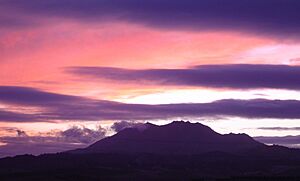
Parks and Trails for Outdoor Fun
Antioch has 31 parks, covering about 310 acres (130 hectares). There are also 600 acres (240 hectares) of open space owned by the city. Plus, there are 11 miles (18 km) of walking paths connecting neighborhoods to parks and schools.
Within Antioch's borders, you'll find Contra Loma Regional Park, the Antioch/Oakley Regional Shoreline, and Black Diamond Mines Regional Park. These three parks cover about 6,493 acres (2,628 hectares). Just outside the city is the 2,024-acre (819-hectare) Round Valley Regional Preserve.
The Antioch Dunes National Wildlife Refuge was created in 1980. It was the first national wildlife refuge made to protect endangered plants and insects. These include the Lange's metalmark butterfly, Antioch Dunes evening primrose, and Contra Costa wallflower. The refuge is on the south shore of the San Joaquin River in Antioch. It protects the last remaining habitat for these special species.
The city has a public marina, along with other private marinas and yacht clubs. There's a public fishing pier in town, and another one on the San Joaquin River near the Antioch Bridge.
Protecting the Burrowing Owl
In 2008, western burrowing owls moved into an area planned for new homes. These owls are a special concern in California. Their population has dropped a lot over the years.
Even though they are protected from harm, their homes can be removed outside of nesting season. In 2009, people protested to protect the owls. Local residents and an environmental group built new, artificial burrows for the owls. This was to help the displaced owls find new homes. Antioch was the first city in the East Bay to set aside land specifically for burrowing owls.
Education in Antioch
Public Schools
Public schools in Antioch are managed by the Antioch Unified School District. The district has:
- Three high schools:
- Antioch High School
- Deer Valley High School
- Dozier-Libbey Medical High School
- Four middle schools:
- Antioch Middle School
- Park Middle School
- Black Diamond Middle School
- Dallas Ranch Middle School
- Many elementary schools.
Private Schools
Antioch also has several private schools, most of which are religious.
- Private high schools include:
- Heritage Baptist Academy (K-12)
- Delta Christian High School
- Promised Land Christian High School
- Private primary and middle schools include:
- Holy Rosary Elementary School
- Hilltop Christian School
- Kinder Care Learning Center
- Antioch Christian School
- Golden Hills Christian School
- Great Beginnings Elementary School
There are also charter schools:
- Antioch Charter Academy (started 1998)
- Antioch Charter Academy II (started 2007)
Western Career College is in Antioch. There is also a school for CPR and First Aid Training.
Public Libraries
The Prewett Library serves Antioch. It is part of the Contra Costa County Library system. You can find it inside the Antioch Community Center.
Media: News in Antioch
The Antioch Press is a weekly newspaper published every Friday. It is mailed to homes and businesses in the city.
The Antioch Ledger was a newspaper that started in 1870. It later merged with the Contra Costa Times and stopped printing in 2005. The Antioch Herald started online in 2010 and then began printing monthly in 2011. Now, it is only available online. East County Today is another online news source that started in 2012. It covers Antioch and other nearby communities.
Transportation in Antioch
Roads
The main road for getting around Antioch is State Route 4. This freeway goes west to Interstate 80 and the rest of the Bay Area road network. It also goes east to Interstate 5 in Stockton, California. State Route 160 goes north from Highway 4. It crosses the San Joaquin River over the Antioch Bridge and goes through the Delta to Sacramento.
Public Transit
Antioch has public transportation options:
- The Antioch-Pittsburg Amtrak station offers train service.
- The Antioch eBART Station connects to the Bay Area Rapid Transit (BART) system. This allows travel to San Francisco International Airport and Oakland International Airport.
- Tri-Delta Transit provides bus services in the Antioch area.
Airports
The closest airport with commercial flights is Buchanan Field Airport. However, it only has one airline, JSX, flying to a few cities. Through BART, you can reach San Francisco International Airport directly. You can also get to Oakland International Airport and San Jose International Airport with transfers.
Notable People from Antioch
Sports Stars
- Frank Beede, former football player
- Paul Blackburn, pitcher for the Oakland Athletics
- T. J. Carrie, professional football player
- David Douglas, professional mixed martial artist
- Najee Harris, professional football player for the Pittsburgh Steelers
- Taiwan Jones, football player
- Maurice Jones-Drew, former football player
- Mike Lucky, former football player
- Gino Marchetti, former All-American football player
- Aaron Miles, retired baseball player
- Sterling Moore, football player
- Jeremy Newberry, former football player
- John Olenchalk, former football player
- Jeff Pico, baseball coach and former pitcher
- Evan Pilgrim, former football player
- Ron Pritchard, former football player and wrestler
- Alex Sanchez, former MLB pitcher
- Gary Sheide, former football quarterback
- Larry Silveira, professional golfer
- T. J. Ward, former football player
Other Famous People
- Chuck Billy, lead singer of the band Testament
- Johnny Burke, lyricist
- Ty Carter, Medal of Honor recipient
- Donovan Cook, film director and animator
- Mario "Mars" Delgado, hip-hop artist
- Carmen Dragon, conductor and composer
- Anthony C. Ferrante, film director (known for Sharknado)
- Wade Harper, first African-American mayor of Antioch
- Leah Laviano, Miss Mississippi USA 2008
- Ronald O. Loveridge, former mayor of Riverside, California
- John Marsh, pioneer important to California statehood
- Lori McCreary, film producer
- Kevin Pereira, TV host
- Mark L. Schneider, former director of Peace Corps
- Lamar Thorpe, current mayor of Antioch
- Tom Torlakson, California Superintendent of Public Education
- Jerome R. Waldie, former United States Representative
- Ryan Mitchell Wood, rapper
Sister cities
Antioch has two sister cities:
 Chichibu, Saitama, Japan (since 1967)
Chichibu, Saitama, Japan (since 1967) Lázaro Cárdenas, Michoacán, Mexico
Lázaro Cárdenas, Michoacán, Mexico
Images for kids
See also
 In Spanish: Antioch (California) para niños
In Spanish: Antioch (California) para niños






